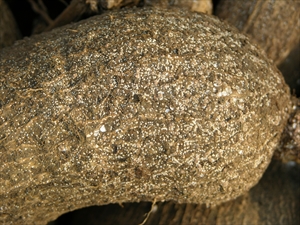- Widespread distribution. West Africa, India, Oceania. On yams, ginger, taro and turmeric are minor hosts. Occasionally, an important disease.
- The scale (1-2 mm diameter) causes a problem in storage. It has long tube-like mouthparts to suck the sap from yams, which then become fibrous. It is covered by a protective shell, called the 'armour'.
- Eggs hatch as 'crawlers'. They walk or are blown in the wind. Both sexes settle down, feed and produce the armour, but males become winged, tiny, mosquito-like insects without mouthparts that mate and then die.
- Cultural control: check each yam tuber before storage, and discard (eat) those with yam scales.
- Chemical control: if scales seen at harvest or during checks in storage, treat with soap, white or horticultural oils with or without malathion.
Pacific Pests, Pathogens, Weeds & Pesticides - Online edition
Pacific Pests, Pathogens, Weeds & Pesticides
Yam scale (093)
Click/tap on images to enlarge
Summary
Common Name
Yam scale, turmeric root scale
Scientific Name
Aspidiella hartii
AUTHORS Helen Tsatsia & Grahame Jackson
Information from CABI (2020) Aspidiella hartii (yam scale). Invasive Species Compendium. (https://www.cabi.org/isc/datasheet/7490). Photos 2&3 Georg Goergen, International Institute of Tropical Agriculture, Cotonou, Benin. Diagram Gillian Watson, California Department of Food and Agriculture, Sacramento.
Produced with support from the Australian Centre for International Agricultural Research under project PC/2010/090: Strengthening integrated crop management research in the Pacific Islands in support of sustainable intensification of high-value crop production, implemented by the University of Queensland and the Secretariat of the Pacific Community.







